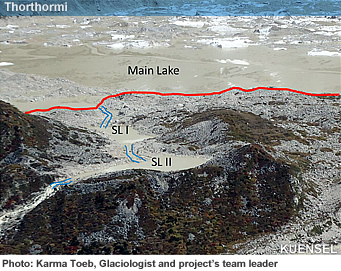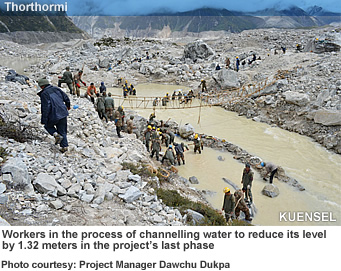| Bhutan's
glaciers and glacial lakes |
 |
Bhutan Glaciers - Glacial Lakes |
|
 |
Bhutan Glaciers - Glacial Lakes |
|
|
 |
|
Lunana's
glacial lakes: ThorthormiTsho
|
|
Thorthormi Mitigation Project
|
 |
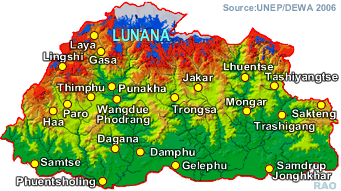 |
Working with just shovels, ropes and muscles at two degrees centigrade, the mitigation team of Lunana in the last five years tamed the most dangerous lake in the country, Thorthormi.
They drained almost the same volume of water that had gushed downstream in 1994 and claimed 21 lives. |
|
By reducing the water level at Thorthormi by five metres, the mitigation team has drained 17 million cubic metres of water into the Phochu through a 10m-wide channel, thereby reducing the risk that such a volume of water could cause downstream.
That is how glaciologists, who worked in Operation Thorthormi at the department of geology and mines, explain the risk reduction aspect of the project.
"By bringing down the water level by five metres, we've reduced the risk downstream by 17 million cubic metres of water," glaciologist and project's team leader, who has been to the site 16 times, Karma Toeb, said."But we can't say by how much the risk of outburst is reduced."
For, what some 300 workers do "up there", for about three months every year, in a lake that's more than 10 times the size of Changlimithang stadium, is "something unnatural" Karma Toeb said.
"In a natural world anything can happen, so even if we drain out half the lake, the remaining water in the lake can cause glacial lake outburst floods (GLOF), but it all depends on external triggering factors, like earthquakes, rock slides and avalanche," he said.
Quantifying the risk from Thorthormi alone is difficult, let alone the risk that has been reduced by lowering the water level by five metres, said project manager Dawchu Dukpa.
"There are other triggering factors that could still cause GLOF, but even then there's risk reduction, because the amount of water released would be a lot less," he said. "However, we can't quantify the risk, because if we're able to quantify the risk, then we might be able to prevent it also."
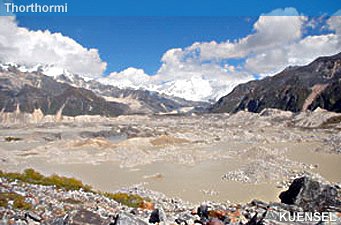 |
| Thorthormi lake (left) and Rapstreng separated by the moraine dam |
|
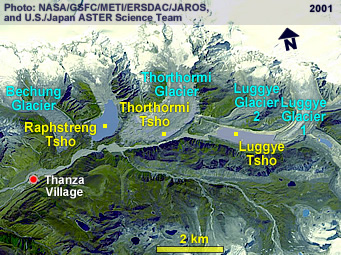 |
Why five metres?
On how the five-metre mark was decided, both Karma Toeb and Dawchu Dukpa said that it was a recommendation by the Austrian consultant in early 2000, with whom they had worked together, and who designed the technical mitigation plan.
The five-metre basis was probably kept as the threshold given the volume of water that was released in 1994 GLOF, which was 18 million cubic metres, almost equal to the volume the Thorthormi mitigation project released. Dawchu Dukpa said mitigation projects in the early ‘90s had also targeted five metres.
With the water outlet constructed, the project team is confident that Thorthormi's water level will not rise."That's the basic reason for this mitigation project, because we wanted the water pressure onto the weakening moraine dam to be as little as possible, and we made sure there is no hydrostatic pressure by draining of the whole volume accumulated there," the project manager said.
Why Thorthormi?
Karma Toeb explained that this project was implemented, based on the worst case scenario, where 53 million cubic metres of water, which is almost three times what gushed out in 1994, could have rushed downstream, if Thorthormi and Rapshteng lakes merged.
"But the risk of outburst is quite high at present and that's why this Lunana complex is quite critical," he said.
Dawchu Dukpa said these two lakes are adjacent to each other, with Thorthormi at a higher elevation; and, in the worst case, it could "overtop" into Raptseng.
"If there was a breach at the dam, then 53 million cubic metres of water could be unleashed from that particular area," he said. "Imagine the damage downstream of this volume."
Studies by the Austrian consultants had projected that there could be a GLOF from Thorthormi as early as 2010.Even though it was just a projection, the lake did not burst, "possibly" because of the mitigation project, Dawchu Dukpa said.
"It hasn't yet happened and, even if it happens, the risk downstream would be much less," he said.
Thorthormi, the officials explained, is not a fully-grown glacial lake, with ice still melting and glacial activity quite active. "It would take some time, may be 5-10 years or more, to really grow into a full grown lake but, in terms of water volume, we have quite an alarming melting going on in there," Dawchu Dukpa said. "Over the last five years, we saw quite a lot of changes there, such as ice having melted quite extensively, and lakes are getting bigger in size."
In its five years of work at the top of the Himalayas to save thousands of lives downstream, the Nu 130M-worth project lost three workers in 2010, one at the site and two on their way.In 2009, two workers suffered frostbite that resulted in them losing their toes.
What next?
"The most important thing is monitoring on an annual basis, because one of our concerns is that the area's glacial dynamics is very active and, over time, it could destabilise the area that we've made and possibly block the channel," project manager Dawchu Dukpa said. "Also, we need to monitor the dead ice in the moraine dams."
While there are no plans yet for such mitigation projects, the officials said that, what has been "done up there" is quite an accomplishment for the team. "It's a big accomplishment because, with the increasing disasters, the best strategy is to reduce the risk," Dawchu Dukpa said. "As a team leader, I'm satisfied with the project we implemented there," added
| Contributed by Sonam Pelden, KUENSEL, Bhutan's National Newspaper, October 2012 |
 |

|
|
WWF Video
|
 |
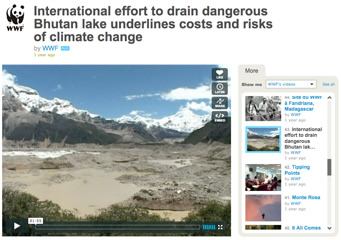 |
 |
 |
External
links |
 |
 |
External
links |
| 29.6
MBPDF-File |
 |
|
|
Information
|
 |
| Links |
 |
 |
 |
External
links |
 |
 |
 |
 |
 |
| GRID-Arendal
News |
NASA's
Global Change Master Directory |
United
Nations Environment Programme |
World
Glacier Monitoring Service |
International
Centre for Integrated Mountain Development |
|
 |
 |
 |
|
|



